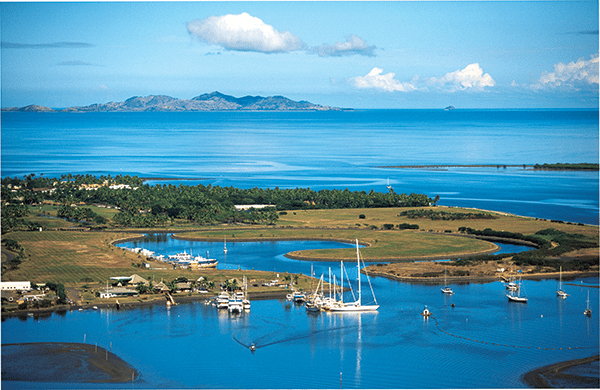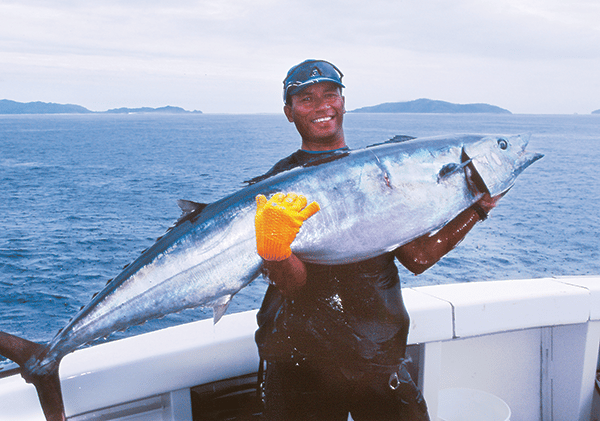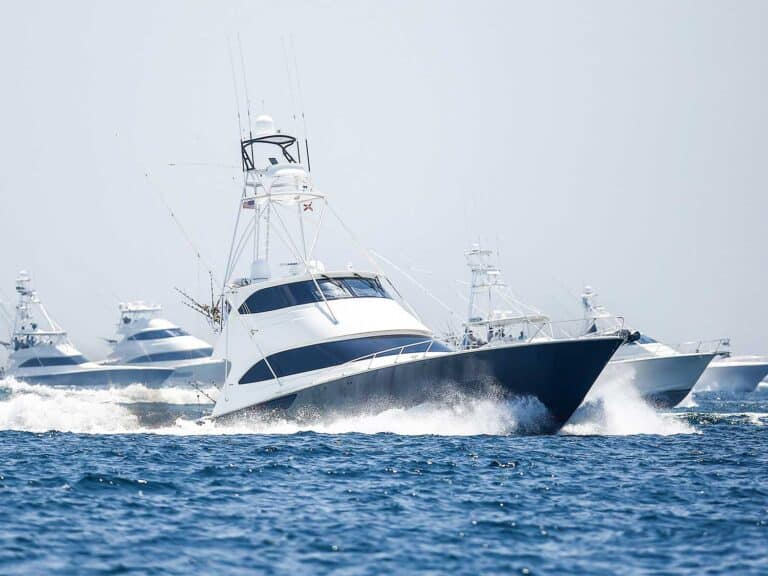
During my first visit to Fiji many moons ago, I fished out of Nadi, one of two large towns on the main island of Viti Levu. I’d heard about the giant wahoo that frequent these tropical waters, and I went prepared with a bunch of wire and a tackle box full of Rapala Magnum minnows. Using only 20-pound tackle, we trolled down the reef edge, and I promptly hooked a 300-pound black marlin! The marlin turned out to be foul-hooked in the top of the head, and it nearly killed me trying to get it to the boat. While the marlin represented a great capture on light tackle, the long three-hour fight put the damper on the afternoon’s plan to pursue wahoo. I really had my sights set catching a giant wahoo.
The captain of the charter boat told me the best place to chase the record-size speedsters was out of Pacific Harbour, where the boats often venture down to the Atrobole Reef along Kadavu Island. I contacted Capt. Brad Cupid from Xtasea Charters, who runs an Australian-built 40-footer called Wai Tadra out of Pacific Harbour, and organized a trip for the following season. Capt. Cupid told me that they have caught quite a number of light-tackle Fiji records, and had been close to breaking a world record on line classes ranging from 6 to 12 pounds many times. Fijian wahoo average around 50 pounds, and quite often 100-plus-pound -monsters hit the deck as well.
The following year, my old mate, Billy Heaton, and I arrived in Pacific Harbour, which is about two-thirds of the way from Nadi to Suva. It lies in an area known as the Coral Coast, and many of the huge, plush hotels and resorts on the main island are situated here. Pacific Harbour itself is quite small, and the nearby Qara Ni Qio River flows into the sea, which provides good ocean access. The harbor does have its limits, however, with the size of the vessels that can get in and out the river — most boats longer than 50 feet have to moor up closer to the river mouth. There is a small mariner at the new Club Oceanus Resort farther upstream, but a low-level road bridge over the river restricts the heights of the vessels that can get up there. It’s a pretty place with plenty of things to do apart from fishing, and the local Fijians are very happy, friendly people.
We caught up with Cupid and his right-hand man, Rob Crause, and they ran through the plan to get us hooked up to some big wahoo. “There are plenty of wahoo, marlin and mahimahi, etc., along the Coral Coast,” said Cupid, but the best grounds are down around Kadavu Island. “It’s only a bit over an hour’s run, or a few hours’ troll, whichever you prefer. We have caught some real nice-size blue marlin in the deep, open stretch of ocean out in front of the island also.”
With the thoughts of big wahoo etched in our minds, we chose to run down to Kadavu, and we left early the next morning. Kadavu is a huge island, and on its southwestern side, an enormous coral reef called the Atrobole runs for more than 60 miles. This beautiful barrier reef represents the fourth largest in the world. Its rugged beauty reminded me of parts of the Great Barrier Reef back home in Australia, and there are plenty of wide, deep openings in the reef to get the boat inside to the crystal clear, calm lagoon. Along the outside edge of the reef, the cobalt Pacific drops away sharply, and the captain was quick to point out: “This is where the big wahoo hunt.”

We quickly sorted our tackle, and the plan was to run a combination of two large minnows and a couple of wire-rigged supersize garfish on 12-pound tackle. The slower 6-knot trolling speed needed for the minnows proved perfect for the gars to skip and splash about off the outriggers, and it didn’t take long to get a bite. One of the minnows took a hit, and I couldn’t quite believe what came out of the water in a half-hearted jump. It was the biggest wahoo I’d ever seen — and I saw a 120-pounder taken on a marlin bait back on the GBR. Unfortunately, the hooks didn’t stick to this absolute monster!
Just seeing such a huge fish gave us hope though, and half an hour later, another wahoo smashed one of the gars, and I was hooked up solid. The Shimano TLD’s spool spun in an absolute blur, and before we could clear the other three outfits and turn to chase the wahoo, the line parted. “What the heck is going on here?” I thought to myself. Even though I was still almost in free-spool, I was cleaned up by the amount of line in the water and the resulting water pressure. The talk of us fishing any line lighter than 12-pound-test was quickly abandoned, and I was sacked for the afternoon as Heaton took over for the next strike. An hour later, I was shown how it was done when he caught a solid 60-pounder after a 45-minute fight. The resort ended up cooking some fine fillets for dinner that night.
We stayed the night at the tiny Naigani Island Resort, and what a neat place this is. The views from its open-air dining deck overlook the ocean swells breaking along the reef edge, and certainly complemented the fresh, barbecued wahoo steaks. The dinner and wine was so good, I quickly forgot about losing what was probably a world-record wahoo. We talked about what we were going to conquer the next day, and just tangling with a few more of these amazing jumbo-size speedsters had us both excited.
Over the following few days, we experienced some amazing action and released several big wahoo in the 40- to 65-pound range, but none were in contention for the 12-pound record. A couple of sailfish also got in on the act, smashing up the big garfish skipbaits, and we released one that probably weighed a good 120 pounds. These fish also turned out to be great sport on the light tackle, and I’d have to say these grounds carry potential for record seekers of many other game species as well. Big wahoo tend to be around most of the year, but the best time is in the temperate months from late winter to early spring — July to September in this part of the world. The following season, a good mate of mine, Tim Simpson from Australia, broke the 8-pound world record on these same fishing grounds, with a wahoo weighing 79 pounds.







